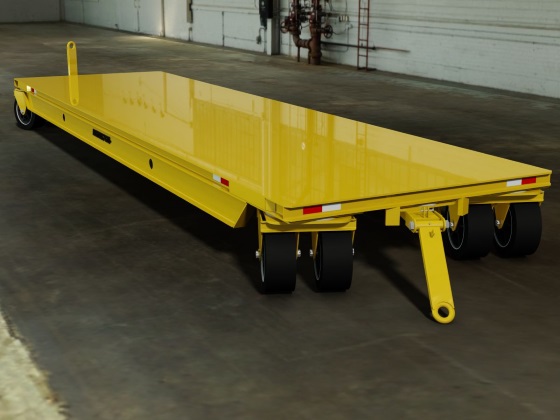Have you ever stopped to ask yourself, Man, how do those incredibly talented engineers at Hamilton do it day in and day out? To be sure, we pride ourselves on spec-ing to your wildest caster and wheel requirements. But that doesn’t mean we make dreams come true without tackling some thorny design challenges.
So we thought it might be fun to grill Hamilton engineering master and commander John Yater about one of his spicier problem-solving projects.
The Challenge:
- Cart type: Structural Steel Transport Trailer
- Load capacity: 30,000 lbs.
- Deck size: 96” x 360”
- Deck height: 30.5”
- Steer type: 4 Wheel Reversible Auto Steer
- Model Number: XT3038
Revolution blog: What was the project and how did it make your life interesting?
Yater: We were asked to create a transport trailer for a steel company that needed to haul large, long, heavy building beams. There were a lot of challenging requirements out of the gate, but as the project wore on, more challenges arose.
Revolution: Such as?
Yater: For starters, the application needed as low a trailer deck as possible, but it also required the largest diameter wheels possible. These two things usually counteract each other.
Revolution: Why a low deck and why such big wheels?
Yater: To get the best performance, we needed a low deck both because the beams have a high center of gravity and because they’re so long they can extend beyond the length of the trailer. We were told the trailers would be traveling across rough concrete floors, so we also needed the largest possible wheels to run smoothly over those floor irregularities.
Revolution: So how do you solve for that?
Yater: Typically, we would suggest a lowboy trailer with a drop deck to accommodate taller loads for extra clearance. But that didn’t work for this customer because their loads were so much longer than the cart. We ended up creating a composite beam for the trailer by welding together two pieces of an i-beam and created bracing to distribute the load weight evenly. The beam is 18” tall at its center, but only 4” tall at the end. Once everything with the composite beam worked mechanically, we had also had to look at hot spots during Finite Element Analysis (FEA) and add bracing to redistribute the stress areas more evenly.
Revolution: Why did you choose 4-wheel reversible auto steering?
Yater: The beam loads are so tall, so stability is important. Auto steer allows you to keep the wheels under the cart corners and keep everything secure. But 4-wheel auto steer also requires a lot of linkage underneath the trailer. Because of this trailer’s low deck height (30.5 inches)—in combination with the beam heights and dimensional constraints—we didn’t have a lot of room underneath the cart to fit all the linkage.
Revolution: How did you fit everything in?
Yater: We fabricated a drag link with openings and ran the other four different linkages through. It was very challenging because we had less than a quarter inch clearance between all the different components. We had to shoehorn everything in. I probably spent the good portion of the day trouble-shooting for clearance issues.
Revolution: Wow. That sounds like painstaking work.
Yater: It was definitely interesting. Also, because positioning all the components underneath was so critical to reduce stress, we had to be very strict about our weld sizes and positioning—that’s usually more forgiving on other projects. Also, because the drag link was so long from front to back, deflection was an issue. So we plasma cut holes through the frame link and put rollers underneath to provide support. This also isn’t something we normally have to do.
